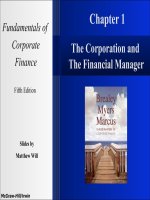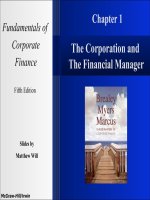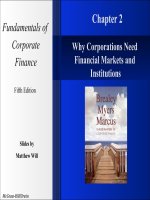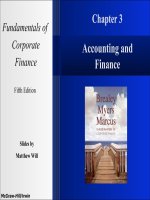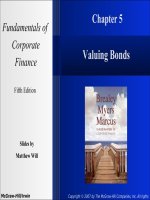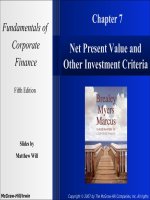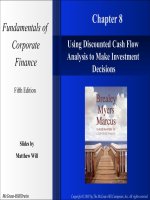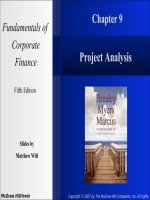Fundamentals of corporate finance 10e ROSS JORDAN chap009
Bạn đang xem bản rút gọn của tài liệu. Xem và tải ngay bản đầy đủ của tài liệu tại đây (1.46 MB, 107 trang )
Chapter
9
Net Present Value and
Other
Investment Criteria
McGraw-Hill/Irwin
Copyright © 2013 by The McGraw-Hill Companies, Inc. All rights reserved.
Chapter Outline
• Capital Budgeting Process
• Payback
• Discounted Payback
• Net Present Value
• Profitability Index
Chapter Outline
(continued)
• The Average Accounting Return
• The Internal Rate of Return
• Modified Internal Rate of Return
• The Practice of Capital Budgeting
Chapter Outline
• Capital Budgeting Process
• Payback
• Discounted Payback
• Net Present Value
• Profitability Index
Capital
Structure
Dividend
Policy
Profits or
Losses
Cost of
Capital
Capital
Budgeting
Capital
Structure
Dividend
Policy
Profits or
Losses
Cost of
Capital
Capital
Budgeting
Uses of Capital Budgeting
Replace
Expand
Maintenance
or
Obsolescence
Current Product
or
Current Service
Cost
Reduction
New Product
or
New Service
Comparison Valuations
0
1
P0
C
0
Bond
2
3
C
C
M
Common Stock
P0
0
COST
1
2
D
D2
1Project
3
D3
1
2
3
CF
1
CF
2
CF
3
D
∞
Bonds, Stock and Project
Similarities
• All three have identified future dollars
that an must be considered
• All three involve bring future dollars
into present value terms
• All three involve an “accept/reject”
decision in the form of purchasing or
not purchasing the entity.
Bonds, Stocks and
Project
Differences
• A bond has coupon payments and a lumpsum payment; stock has dividend
payments forever; projects have cash flows
that end.
• Coupon payments are fixed; stock
dividends change or “grow” over time;
project cash flows are typically different
each year.
Bonds, Stocks and
Project
Differences
• With bonds and stock our goal is to
determine the value today (P0); our goal
with projects is to determine if we will
exceed our cost with the cash flows
identified.
Our Task:
To determine if we
should purchase
the project
And how will we
accomplish our
task?
B
A
E
F
E
I
P
V
T
Bring
All
Expected
Future
Earnings
Into
Present
Value
Terms
Just remember:
BAEFEIPVT
Chapter Outline
• Capital Budgeting Process
• Payback
• Discounted Payback
• Net Present Value
• Profitability Index
Payback Period
Definition: How long does it take to get the
initial cost back in a nominal
sense?
Computation:
1. Estimate the cash flows
2. Subtract the future cash flows
from the initial cost until the
initial investment has been
recovered
Project Example
Information
You are reviewing a new project and have estimated
the following cash flows:
Year 0:
Year 1:
CF = -165,000
CF = 63,120; NI = 13,620
Year 2:
CF = 70,800; NI = 3,300
Year 3:
CF = 91,080; NI = 29,100
Average Book Value = 72,000
Your required return for assets of this risk level is
12%.
Project Example - Visual
R = 12%
1
$ -165,000
CF1 =
63,120
2
CF2 =
70,800
3
CF3 =
91,080
The required return for assets of this risk level
is 12% (as determined by the firm).
Payback Computation
R = 12%
1
$ -165,000
CF1 =
63,120
2
CF2 =
70,800
3
CF3 =
91,080
Year 1: $165,000 – 63,120 = 101,880
We need to get to zero so keep going…
Payback Computation
R = 12%
1
$ -165,000
CF1 =
63,120
2
CF2 =
70,800
3
CF3 =
91,080
Year 2: $101,880 – 70,800 = 31,080
We need to get to zero so keep going…
Payback Computation
R = 12%
1
$ -165,000
CF1 =
63,120
2
CF2 =
70,800
3
CF3 =
91,080
Year 3: $31,080 – 91,080 = -60,000
We “passed” zero so payback is achieved
Payback decision
So….Deal
or No Deal?
Payback Decision
We need to know a “management’s number.
What does the firm use for the evaluation
of its projects when they use payback?
Most companies use either 3 or 4 years.
Let’s use 4 in our numerical example
Payback Decision
Our computed
payback was 3 years
The firm’s uses 4
years as it’s criteria,
so…
YES, we Accept this
project as we recover
our cost of the
project early.
